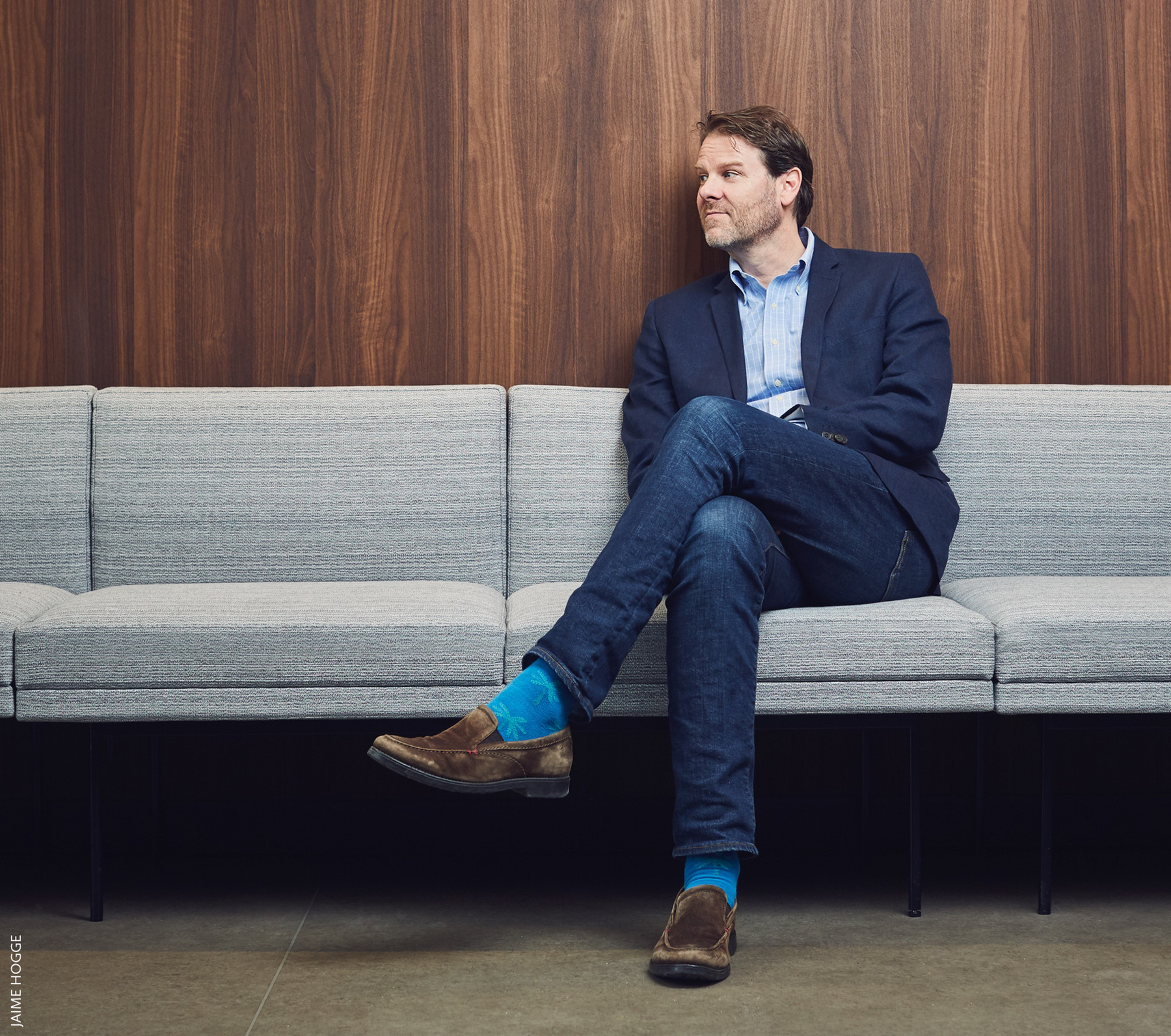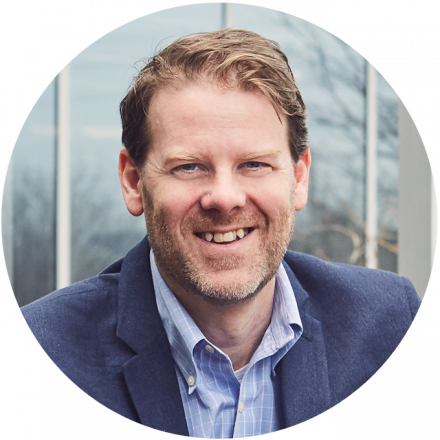Drive my Car

Ted Graham, head of open innovation at General Motors, leans forward in his chair to talk about — of all things — rock paper scissors. It’s my fault, really. We’re in a meeting room in one of GM’s offices in Oshawa, Ont., to discuss the future of cars — something Ted is intimately involved with. But when I learn that Ted (pictured above) was once a world-ranked rock-paper-scissors player, well…I just have to ask about that!
“If you throw three rocks in a row, it’s called an avalanche. Three papers in a row is a bureaucrat,” he explains. As for playing advice, stay calm, he advises. “When people are nervous and they’re throwing scissors, for example, they throw too early. Their arm is only halfway down. Most people don’t notice this sort of thing. But I kind of slow my world down. Watching someone forming scissors with their arm halfway down…obviously I’m going to crush them with my rock.”
Rock paper scissors is just one of several pursuits and occupations Ted has had in his 47 years. Others are magazine publisher, volleyball player, philosopher, PR manager, UberX driver and author. Then there was the time he worked with the FBI. But more on that later. Back to cars.
Hop in. Let’s go for a ride
Two years ago, GM created a new position to oversee what it calls “open innovation”, and hired Ted for it. He recently described what he does this way: “I’m the guy with the crazy title at a big Fortune 50 company trying to innovate faster than not only our traditional competitors but also Silicon Valley…” To do that, Ted works with startups, incubators and other companies to solve transportation problems, both GM’s and others’. For example, GM works with UrbanLogiq, a Vancouver startup that uses real-time traffic data to help cities do urban planning. GM provides UrbanLogiq with some of its own data and other support.
Much of Ted’s work revolves around Internet-connected cars and autonomous vehicles (AV). Next year, GM will start commercial production of a self-driving car, the Bolt AV. Its most notable feature: no steering wheel.
Ted says self-driving cars can ease three big societal problems: emissions, congestion and traffic fatalities. To curb emissions, GM’s autonomous vehicles will be electric. To reduce congestion, AVs can choose the best route based on traffic conditions and can safely follow each other closer than people-driven cars. As for deaths, more than 1.2 million people are killed in traffic accidents worldwide a year. Almost always the cause is human error. AVs could drastically lower that number.
“If you told a car company they’d be measured by anything but vehicles sold, they wouldn’t have believed you. But I talk about ‘kilometres enjoyed.’”
Ted recently took to the back seat of a self-driving car in the tight, up-and-down streets of San Francisco. The experience, he says, was “fun and not at all scary.” But it demonstrated the challenges of driverless cars. At one point, a truck ahead stopped suddenly. The driver got out and placed pylons in front and behind his truck, creating an instant, albeit illegal, parking spot. AVs must be able to handle this situation and many more to ensure a safe trip for passengers, other drivers and pedestrians.
Not all future driving will be autonomous, of course. People may let their car drive them to work on busy city streets, then get behind the wheel when driving becomes more fun, such as on country roads. But our love affair with cars is changing. Ted cites a survey that asked 16-year-olds what they would give up first: their driver’s licence or Wi-Fi. Most said they’d ditch their driver’s licence. What will this new generation want from cars? GM wants to know. “A few years ago, if you told a car company that they would be measured by anything but vehicles sold, they wouldn’t have believed you. But I often talk about measuring success by ‘kilometres enjoyed.’”
This is what I did
Ted may work for one of the world’s biggest companies, but he still sees himself as an entrepreneur. It’s a mindset he learned from his mom growing up in Nova Scotia. When Ted was born, his parents lived in Judique, N.S., a small paper-mill town on the western side of Cape Breton. But his dad longed for a better life and so enrolled in law school. Upon graduation, he got a job with a law firm in Dartmouth, N.S., and the family moved to the city.

Look, no hands! Next year GM will begin commercial production of a self-driving car that does not have a steering wheel.
After high school, Ted figured he might go to law school, but his dad dissuaded him. “He told me I was too broad a thinker.” So, he studied philosophy at the University of Toronto. He also wrote for the university newspaper, The Varsity, and ran to be its editor, but lost to another student, Naomi Klein.
Ted graduated in 1992 — smack dab in the middle of the early ’90s recession. Philosophy grads were hardly in demand. Or, as he puts it, “No one was looking for an entry level epistemologist. I knew I was going to have to make a job for myself.” To do that Ted combined two of his favourite things: publishing, learned at The Varsity, and volleyball, a sport he’d played competitively as a member of Team Nova Scotia at the Canada Games in 1989. The result was a monthly magazine, called V Canada (later True North Volleyball and Volleyball Canada). Ted was publisher but he also sold ads, wrote articles and hired writers and graphic artists. Within a few years the magazine was on newsstands, with a readership of more
than 100,000.
But running a magazine was complicated and so Ted decided to get his MBA. He applied to Queen’s but was unsure of acceptance. Did MBA programs take philosophy undergrads? He didn’t think so. At the last minute he slipped a copy of his magazine into the application. “I wanted to say, ‘Look at this. This is what I did.’ ” He got in.
Unlike most MBA students, Ted didn’t see a graduate degree as a step to further his career. He simply wanted to be a better publisher. Though he would continue to run Volleyball Canada on the side until 2007, other jobs soon came his way. One of those, in 1996, was at National Public Relations in Toronto. There, Ted used his subscription-list and database-management skills to create something new and novel for the early Internet era: automated news alerts, providing faster information updates to the PR firm’s clients.
Two years later he went to Hill & Knowlton where, as worldwide director of knowledge, he co-developed a tool called the Influencer Network Analysis. It allowed companies to better find and target key influencers, such as bloggers, using the same type of technology that helped professors identify plagiarized student papers. In 2005, PR Week named Influencer Network Analysis its Product of the Year. It was at Hill & Knowlton that Ted began also playing rock paper scissors competitively; a co-worker’s husband had written a book about the game. A few years later, he moved to do consulting at McKinsey, then to Interbrand, followed by PricewaterhouseCoopers, before GM in 2016.
The gig economy
An interest of Ted's throughout his career has been to understand how ideas are spread and how people connect — including at work. Back in the 1990s at Hill & Knowlton, for example, most people had walled offices. How to get them to interact with co-workers more often became a question. One solution Ted worked on was a Friday afternoon beer cart. Each week, a different employee pushed the cart around, and new employees were always given a turn. “We had a waiting list of people who wanted to push the cart. It was a huge success.”

Need a Lyft? In recent years GM has invested in car sharing services Maven and Lyft.
More recently Ted turned his attention to the sharing and gig economies. In 2011, Ted joined PwC, and a few years later, as innovation leader, found himself preparing a speech on the rise of Uber, Airbnb and other sharing businesses. To better understand them for his speech, Ted could have commissioned research or simply read a few articles. Instead, he decided to experience them first-hand by becoming an UberX driver. Soon he was ferrying passengers around Toronto in his family’s minivan. “I remember my hands shaking the first time I allowed a stranger into the back of my car. But I wanted to know how the supply side of the sharing economy worked.”
The experience led Ted to write a book, The Uber of Everything: How the Freed Market Economy is Disrupting and Delighting, and he became a recognized expert on the gig economy. Eventually GM came calling. The automaker already owned part of the ride-sharing service Lyft. The year Ted joined, it launched Maven, a car-sharing service, in several U.S. cities. Earlier this year, Maven opened in Toronto, too.
A point Ted makes is that there will be more changes in transportation in the next five years than in the last 75. A lot of that will occur in urban areas. By 2030, most of the world’s population will live in megacities. Car companies like GM will need to cater to the unique transportation needs of the people who live there. It’s a big change from the suburban car boom that fuelled an earlier era of GM’s growth. With self-driving cars and services like Maven, GM “is making a bold bet on how to think about urban mobility in the future,” Ted says.
His job is to help ensure GM is in the driver’s seat of that change — steering wheel or not.

